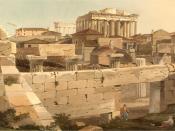Throughout the ages, animals have been a source of fascination to humans. Whether loyal companions, enemies, or a means of sustenance, animals with their kindness, strength, beauty, and mystery have inspired people to create works of art (http://www.artsmia.org/animals/). "Throughout history there have been representations ranging from the realistic, to myth[ical], legend[ary], symbol[ic], and even murderous beasts; at the same time providing fascinating perspectives of our own humanity" (http://www.collegepapers.com/TermPapers/Art/Animal_Influences_in_Paleolithic_Egyptian_and_Greek.shtml). Animal art has also been seen as a tool connecting different cultures and time periods.
The horse has been a favorite subject of artists for centuries. Mans first attempt to portray the horse in art was in prehistoric times when they were drawn on cave walls. As world cultures developed, horses were depicted in pottery, sculpture, painting, mosaics and other art forms. "An inspiring symbol of strength, freedom, power and beauty, the horse was vital in agrarian economies before the Industrial Revolution" (http://www.unicover.com/H0003560.htm).
Farmers used them to clear land and plow fields. Cowboys and shepherds used them to herd cattle and sheep, while people in the cities depended on them for delivering goods. Artists also portrayed horses in scenes of leisure and sport, such as horse racing.
During prehistoric times, art was almost entirely limited to the drawings of animals. This was probably due to the prehistoric people's dependence on animals for food (http://www.collegetermpapers.com). "The life of Paleolithic man was determined by the animals around him" (Brion, 10). The deer, cows, horses, and bison that appeared in their pictures all inhabited Europe at that time. It is thought that the cavemen painted and carved because they believed that the pictures would bring them luck in their future hunts (Wallace). It is also thought that the spear marks drawn onto the animals or the actual spear points on these animals were to simulate...


